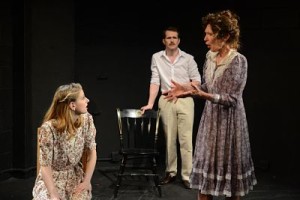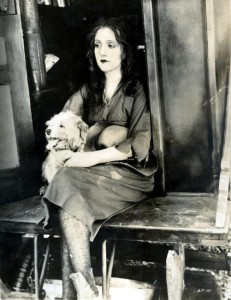Admittedly a fiction, Steven Carl McCasland’s stage drama What Was Lost is a juicy morsel for theatre buffs: a re-imagining of the events surrounding the original 1945 production of The Glass Menagerie. It is an event enshrined in theatrical legend. The unknown author, Tennessee Williams (Paul Thomas Ryan), would become the most important American playwright of the post-war era; and the star, Laurette Taylor (Pennylynn White), after years out of the limelight and struggles with alcoholism, would make the greatest comeback in Broadway history.
Before World War I, during America’s age of alleged innocence, Taylor became a Great White Way luminary in Peg O’ My Heart, written for her by her second husband, J. Hartley Manners. It was a formulaic comedy: working class girl teaches rich folks the meaning of true happiness. The couple repeated the formula in a number of vehicles with great commercial success. While critics admired the luminosity of Taylor’s acting, they decried her decision to only appear in her husband’s plays. As the Twenties roared, Manners was clearly out of touch. Taylor made less frequent appearances in different authors’ plays (always enjoying great acclaim). She also took refuge in alcohol. By the early Thirties, she was uninsurable. Then, in 1938, she played a character role in a revival of Sutton Vane’s Outward Bound. She received twenty-two curtain calls. Re-established, she waited six years for “the role.” Enter Williams.
In What Was Lost, McCasland effectively depicts the plunge into the unknown—with its terrors and exhilarations—that is a production of a new play. At times, he evokes Williams’ “memory play” techniques as the characters’ art and lives intertwine. McCasland also directs and moves his uniformly excellent ensemble to good effect. Kristen Gehling is a take-charge dynamo as producer Margo Jones; Ryan is alternately haughty and insecure as Williams; best of all, appropriately, Pennylynn White captures Taylor’s boozy Irish humor, ethereal weirdness and powerful tenacity.
Burton Rascoe, reviewing the opening of The Glass Menagerie wrote of the star: “…I can’t say anything adequate…you can’t describe a sunset…”
There is scant recorded evidence of Laurette Taylor’s artistry: three silent films, a radio play and a screen test.
The radio play is Wealth and Wisdom by Oliphant Down and can be found on Youtube.
The terrific 1969 made-for-television documentary Hollywood: The Selznick Years contains her screen test from the early thirties. A slight piece, it is introduced by Henry Fonda as the only sound filmed record of the “greatest English speaking actress’ of her time.
Then, there are three silent film versions of her husband’s plays: Peg O’ My Heart (1922), Happiness (1923), and One Night in Rome (1924). The latter two are rumored to be languishing in a vault in Hollywood.
Peg is available and is a fascinating document. The studio entrusted a young King Vidor (Bird of Paradise) with guiding the great stage star (then nearing 40) through her first film, playing an Irish teenager. Relieved to find she had a youthful face, he was nevertheless spare in his use of close-ups, shooting medium and long shots. This allows us to see the actress’ mercurial interactions with her fellow players, a hallmark of her acting style. As is the case with other stage stars of her era, one is struck by Taylor’s intense physicality. At times, she seems to be dancing the role of Peg.
“There is nothing more ephemeral than theatre fame,” wrote Marguerite Courtney, Taylor’s daughter, in the biography Laurette.
It’s an excellent biography and one the best books ever about the workings of the theatre. Ironically, it is that sense of the elusive about Laurette Taylor, a whiff of something slightly out of reach that continues to fascinate. And, of course, Americans love a comeback!
What Was Lost continues at the Clarion Theatre, 309 East 26th St. in New York as follows: Wed. 5/20 at 2PM, Sat. 5/23 at 5PM, Thurs. 5/28 at 7PM, Sat. 5/30 at 5PM and Sun 5/31 at 7PM. Tickets: www.tinyurl.com/InRepertory.


Leave a Reply